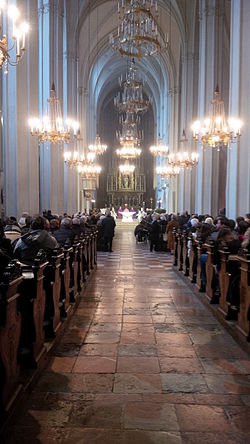Augustinian Church, Vienna
| Augustinerkirche | |
|---|---|
 | |
| Religion | |
| Affiliation | Catholic Church |
| Ecclesiastical or organizational status | Active |
| Leadership | P. Matthias Schlögl, OSA |
| Year consecrated | 1349 |
| Location | |
| Location | Vienna, Austria |
| State | Vienna |
| Architecture | |
| Architect(s) | Dietrich Landtner |
| Type | Church |
| Style | Gothic, Baroque |
| Groundbreaking | 1327 |
| Completed | 1339 |
| Specifications | |
| Direction of façade | NW |
| Length | 85 m (278.9 ft) |
| Width | 20 m (65.6 ft) |
| Width (nave) | 11 m (36.1 ft) |
| Website | |
| www | |
The Augustinian Church (German: Augustinerkirche) in Vienna is a parish church located on Josefsplatz, next to the Hofburg, the winter palace of the Habsburg dynasty in Vienna. Originally built in the 14th century as the parish church of the imperial court of the Habsburgs, the harmonious Gothic interior was added in the 18th century. The official name of church and parish is St. Augustin, but it is locally called Augustinerkirche.
History
In 1327, Duke Frederick the Handsome (Friedrich der Schöne) founded this church with a cloister for the Augustinian friars.[1]
In 1634, the Augustinerkirche became the parish church of the imperial church. As imperial church, many Habsburg weddings took place there, including the wedding of Archduchess (and future Empress) Maria Theresa in 1736 to Duke Francis of Lorraine, the wedding of Archduchess Marie Louise in 1810 to Emperor Napoleon Bonaparte of France, and the wedding of Emperor Franz Joseph in 1854 to Duchess Elisabeth in Bavaria.
A functioning monastery of six black-robed Augustinian monks remains, serving the needs of the parish.
Exterior

The Gothic church is 85 m (278.9 ft) long and 20 m (65.6 ft) wide. The nave is 11 m (36.1 ft) wide.[2]
Interior
The nave was built under architect Dietrich Landtner from 1330 to 1339, but not consecrated until 1 November 1349. As the nearby Hofburg expanded, the Augustinerkirche gradually became engulfed by it and today is a part of the complex. Although inconspicuous from the outside, the inside is more ornate. During the reign of Emperor Joseph II, 18 side altars were removed in 1784 when the church was restored in the gothic style. A new side altar was added in 2004, dedicated to Emperor Karl I of Austria (1887–1922) who is on the path to being recognized as a saint by the Roman Catholic Church.
Chapels
The Loreto Chapel, to the right of the main altar, holds the silver urns containing the hearts of Habsburg rulers, while their bodies are kept in the Imperial Crypt. Herzgruft contains the hearts of 54 members of the imperial family.[3]
Cenotaph of Maria Christina
Notable among the church's monuments is the memorial to Archduchess Maria Christina of Austria sculpted by Antonio Canova, in 1805.
Sacred music
Composer Franz Schubert conducted his Mass in F major there, and Anton Bruckner's Mass in F minor was written for the church and was first performed there. In the 21st century, the church is known to host high quality sacred music concerts, particularly for its weekly Sunday High mass with full orchestra and choir. The church has two organs.
Gallery
-
Interior
-
Altar
-
Rieger Organ
-
Bach Organ
-
Chandeliers
-
Side altar with painting of Emperor Karl I
Cenotaph for Archduchess Maria Christina
References
- Citations
- ^ "Augustinerkirche". Wein-Vienna. Retrieved 29 January 2013.
- ^ Estimated specifications from satellite images provided by Google Earth
- ^ "Die Herzgruft in der Loretokapelle" (in German). Augustinerkloster. Retrieved 11 December 2007.
- Bibliography
- Brook, Stephan (2012). DK Eyewitness Travel Guide: Vienna. London: Dorling Kindersley Ltd. ISBN 978-0756684280.
- Gaillemin, Jean-Louis (1994). Knopf Guides: Vienna. New York: Alfred A. Knopf. ISBN 978-0679750680.
- Meth-Cohn, Delia (1993). Vienna: Art and History. Florence: Summerfield Press. ASIN B000NQLZ5K.
- Schnorr, Lina (2012). Imperial Vienna. Vienna: HB Medienvertrieb GesmbH. ISBN 978-3950239690.
- Schulte-Peevers, Andrea (2007). Alison Coupe (ed.). Michelin Green Guide Austria. London: Michelin Travel & Lifestyle. ISBN 978-2067123250.
- Toman, Rolf (1999). Vienna: Art and Architecture. Cologne: Könemann. ISBN 978-3829020442.
External links
- "Geschichte der Kirche St.Augustin" (in German). Augustinerkloster. Retrieved 11 December 2007.
- "Die Herzgruft in der Loretokapelle" (in German). Augustinerkloster. Retrieved 11 December 2007.
- Official website













